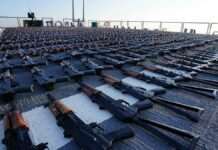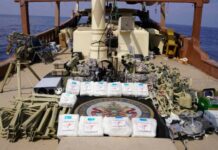The proliferation of unmanned aerial vehicles (UAVs) is transforming conflicts, both ashore and afloat.
Unmanned aerial vehicles are increasingly used for kinetic and non-kinetic attacks, along with their primary intelligence, surveillance and reconnaissance (ISR) mission. Attack UAVs – in function effectively cruise missiles – have been extensively used in the Red Sea, Syria and Iraq, Nagorno-Karabakh and Ukraine; a United Kingdom Ministry of Defence intelligence update on Ukraine on 1 November 2023 described them as “one of the most effective new capabilities”. The counter-UAV (C-UAV) target set is often slow, low-observable, operating at low altitude and often amid ground clutter, and, above all, cheaper and easier to deploy than the surface-to-air missiles (SAMs) that can intercept them. Then-Marine General Kenneth McKenzie Jr., commanding US Central Command (CENTCOM), said in a speech to the Middle East Institute in Washington on 7 February 2021, “The growing threat posed by these systems, coupled with our lack of dependable, networked capabilities to counter them, is the most concerning tactical development.”
C-UAV is not limited to niche or specialised assets, but overlaps with integrated air and missile defence (IAMD) and indirect fire protection capability (IFPC), the latter focussing on the counter – rocket, artillery and mortar (C-RAM) mission. All three mission areas focus on active defence – defeating threats after launch – but also include attack operations and passive defence, all made possible by BM/C4I (battle management/command, control, communications, computers and intelligence). As with IAMD and ICPC, no single, affordable ‘silver bullet’ solution for C-UAV is possible. Rather, an effective architecture integrates disparate systems across service and national lines.
In the US and worldwide, “the production for counter-UAS [has] to go through the roof,” Bill LaPlante, Under Secretary of Defense for Acquisition and Sustainment, said during the Reagan National Defense Forum in California on 3 December 2023. Maximising system capabilities, sustaining high production rates and expanding magazine size – and minimising the associated cost – is critical to fielding effective C-UAV systems. He said, “Everything I said has to be affordable; if it costs USD 1 million a round and you’re going against a USD 100,000-or-less cheap UAS – they’ve won”.

Credit: USMC/Sgt Melissa Marnell
In FY 2023, the US Department of Defense (DoD) allocated USD 668 million for C-UAV research development test and evaluation (RDT&E) programmes and at least USD 78 million for procurement. Even though procurement funding increased to USD 365 million in the Army’s FY 2024 request, “It is mostly RDT&E because they are prototypes,” LaPlante said. “We’ve got to move that to production…counter-UAS capabilities, at scale. We need lots of money…we need production lines to go fast.” The Army, as the lead service for the C-UAV mission, is planning on introducing a dedicated C-UAV funding line in the FY 2025 budget request, due in March 2024.
In 2019, the DoD established the Joint C-small UAS Organization (JCO) with responsibility to enable the defeat of UAVs in Group 1 (UAVs weighing up to 9 kg, flying under 457 m at less than 185 km/h), Group 2 (11–25 kg, up to 3,500 feet and 250 kn) and Group 3 (up to 600 kg, 1,067 m and 463 km/h). The US Army has made defence against UAV Group 3 – including many attack UAVs – the responsibility of air defence units. All combat and support units will be trained and capable of defending against widely proliferated Group 1 and 2 UAVs.
The US effort has parallels in international RDT&E programmes, such as the UK’s Project Synergia, which was declared to reach initial operational capability (IOC) in 2020. The first of the now-annual NATO C-UAS Technical Interoperability Exercises (TIE), in 2021, brought together over 70 systems and has expanded since then. In 2023, NATO moved towards issuing its first C-UAS doctrine document and adopted the UK-developed SAPIENT (Sensing for Asset Protection with Integrated Electronic Networked Technology) protocol developed as an open standard for the fusion and integration of sensor data into a single integrated picture.
C-UAV technologies
Sensor technology – to detect, identify, classify and track UAVs – includes radars with active electronically scanned array (AESA) and pulse Doppler technologies, though the latter can be problematic in filtering out slow-moving UAVs in ground clutter. Longer-range radars, such as the Lockheed Martin AN/TPQ-53 radar, with upgrades since FY 2016, can be networked through the US Army’s Northrop Grumman Forward Area Air Defense (FAAD) command and control (C2) system, which the JCO has mandated as a joint service C-UAV C2 system. Optronic/infrared, acoustic (using networked sensors) and radio frequency sensors (analysing the electromagnetic spectrum to detect and locate UAV activity) have proven valuable in the conflict in Ukraine. Artificial intelligence (AI) and machine learning (ML) technologies are being applied to the C-UAV mission. Identification Friend or Foe (IFF) and airspace deconfliction issues remain problematic, especially for non-specialist units carrying out self-defence C-UAV – an attack UAV succeeded against US troops in Jordan in January 2024 reportedly because US forces mistook the hostile drone for a friendly one.
Integrated C-UAV systems: LIDS and MADIS
Integrated, deployable systems include the US Army’s Fixed Site-Low, Slow, Small UAV Integrated Defeat System (FS-LIDS), which is mounts the system components on transportable pallets and tripods. Its mobile version is the Mobile-Low, Slow, Small UAV Integrated Defeat System (M-LIDS) Increment 2 mounted on a pair of Oshkosh M-ATV light trucks integrated by Leonardo DRS, one configured for kinetic effects and the second for electronic warfare (EW).
These LIDS systems share many components, including the FAAD C2 system, the Syracuse Research Corporation (SRC) Counter-Small UAV Electronic Warfare System Direction Finding (CUAEWS DF) system to provide direction finding and jamming capabilities, and an optronic sight with day and infrared (IR) channels.

Credit: US ANG/Spc Everett Sharp
The primary kinetic effector used for FS-LIDS/M-LIDS is the Raytheon Coyote Block 2 disposable anti-UAV munition (effectively a subsonic, rocket boosted, turbojet-powered SAM). The available radars for use with FS-LIDS/M-LIDS are the Raytheon Ku-band Radio Frequency Sensor (KuRFS) radar and the SRC AN/TPQ-50. The US Army awarded a USD 426 million contract for AN/TPQ-50 radars for use with its FS-LIDS configuration on 4 December 2020. Later the Army awarded RTX two contracts – a USD 207 million contract on 10 October 2022, followed by a USD 237 million contract on 19 April 2023, both for KuRFS radars and Coyote family effectors, for use with FS-LIDS/M-LIDS.
The M-LIDS kinetic effects vehicle mounts a Moog Reconfigurable Integrated-weapons Platform (RIwP) armed with a Northrop Grumman XM914E1 30 mm Bushmaster chain gun and a co-axial M240 7.62 mm machine gun (MG). The electronic warfare vehicle is armed with a M2 12.7 mm heavy machine gun (HMG) provided with a Ballistic Low Altitude Drone Engagement system (BLADE) specialised C-UAV sight. While the M-LIDS Increment 2 configuration is based on two M-ATV 4×4 protected patrol vehicle platforms, M-LIDS Increment 3 seeks to combine the kinetic and EW M-LIDS capabilities onto a single armoured vehicle.
The Army had planned to equip 10 divisions with five M-LIDS sets each. Major General Sean Gainey, head of the JCO, said in a talk in Washington D.C. on 15 November 2023, “Every division will have a counter-UAS battery manned by air defence soldiers.” In December 2023, when two divisions had started to receive M-LIDS, the Army announced its intention to expand the programme. M-LIDS is currently deployed to the Central Command (CENTCOM) area of operations.
The Army has asked industry for information on enhancing its Maneuver Short Range Air Defense (M-SHORAD) Increment 3 programme with upgraded C-UAV capability, incorporating the Coyote Block 2+ and non-kinetic capabilities into the Stryker series of wheeled AFVs used in the current M-SHORAD Increment 1. BAE Systems has developed a version of its Advanced Multi-Purpose Vehicle (AMPV) tracked AFV platform, mounting a RIwP turret, configured as on the M-LIDS kinetic effects vehicle. In January 2024, this vehicle carried out live-fire testing at the Big Sandy Range in Arizona.
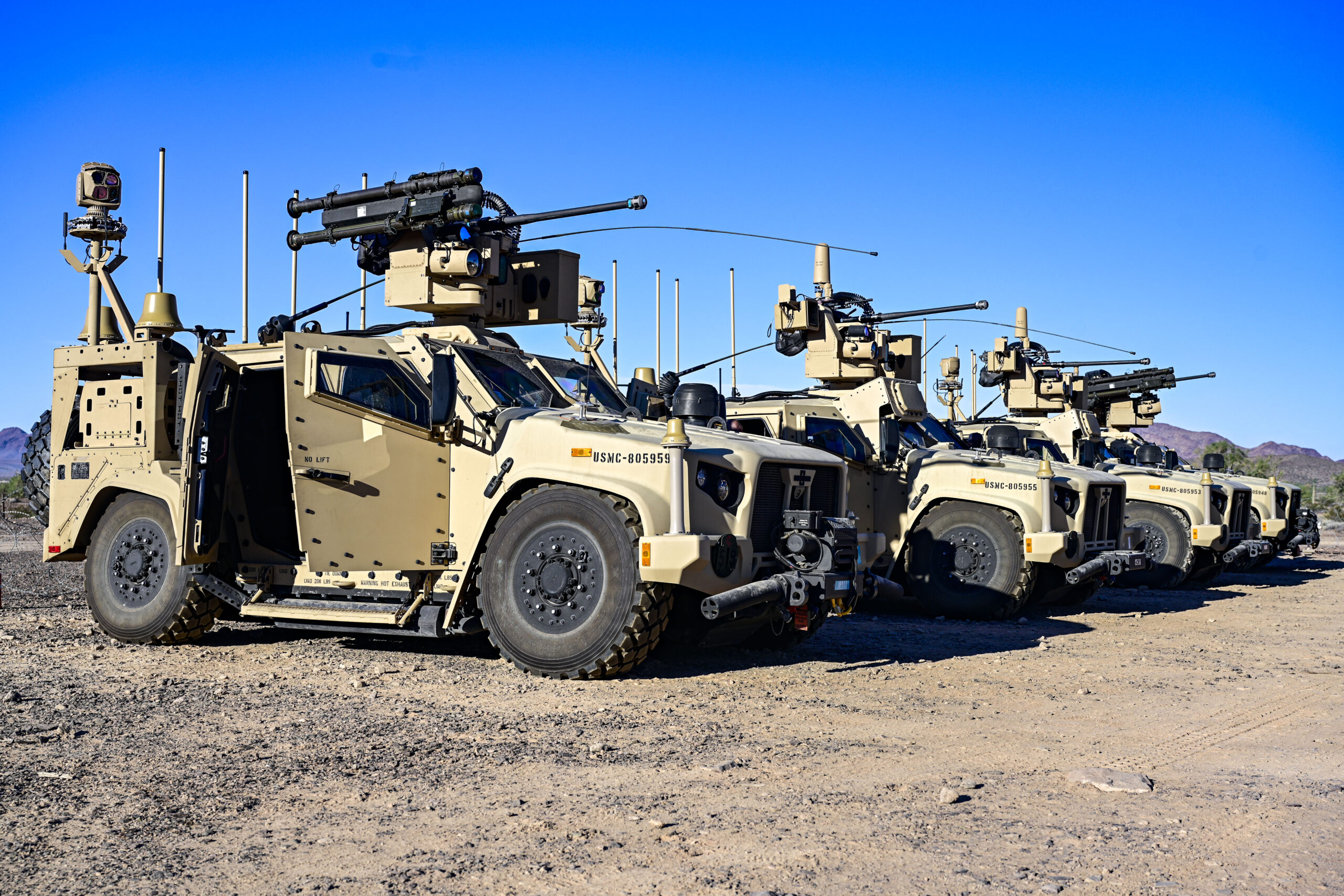
Credit: US Navy/Neil Mabini
The US Marine Corps’ three new Littoral Area Air Defense (LAAD) battalions will use the AN/MSY-2 Marine Air Defense Integrated System (MADIS) Mk1 and Mk2 vehicles, based on the Joint Light Tactical Vehicle (JLTV). As with the M-LIDS, the MADIS Block I operates as a two-vehicle set. Both vehicles use the SAIC Multi-Environmental Domain Unmanned Systems Application Command and Control (MEDUSA C2) system, which is being made interoperable with FAAD C2.
The MADIS Mk1 is fitted with a Kongsberg Defense Protector RS6 remote weapon station armed with a 30 mm chain gun, an M240 7.62 mm MG, and two FIM-92 Stinger family missiles. The vehicle also carries a mast-mounted gimballed sight in the form of the Ascent Vision Technologies CM262. The MADIS Mk2 appears to feature the same equipment as Mk1, but is additionally fitted with that appear to be four RADA aCHR (RPS-62) radars, along with a fairing for an antenna on top of the turret, thought to be part of an EW system. The two vehicles are intended to operate together and complement each other’s capabilities. In December 2023, MADIS successfully carried out live-fire systems integration testing at the Yuma Proving Ground. It entered low-rate initial production (LRIP) in June 2023 and is planned to enter full-rate production in FY 2024.
Light MADIS (LMADIS) versions, using Polaris vehicles, started initial operational testing and evaluation (IOT&E) in October 2022. LMADIS is a two-vehicle system, with one vehicle carrying the sensors, including four RPS-62 radars, and CM262 sight, and the second understood to carry an SNC Modi II EW system. On 17 July 2019, a developmental variant of LMADIS aboard the amphibious warfare ship USS Boxer was reported to have been involved in the downing of an Iranian UAV during the Boxer’s transit through the Strait of Hormuz, reportedly downing the UAV via EW.
Low-cost multi-mission interceptor: VAMPIRE
By early 2023, the US had reportedly sent Ukraine such a large quantity of Stingers that it would require 13 years’ worth of production at recent levels to replace them. This demonstration of the scope of missile consumption has been given additional impetus by the rise of C-UAV requirements. To provide a low-cost multi-mission C-UAV capability, in 2023, the US Navy’s Naval Air Systems Command (NAVAIR) developed, and L3Harris integrated, the Vehicle-Agnostic Modular Palletized ISR Rocket Equipment (VAMPIRE), a bolt-on combination of mast-mounted optronic sensor and a quadruple launcher firing the BAE Systems AGR-20 APKWS (Advanced Precision Kill Weapon System), a semi-active laser (SAL) guided 70 mm rocket, which is also offered in a variant fitted with an L3Harris/TSC radio frequency (RF) proximity fuze for the C-UAV role. Tested for use against Group 2 and 3 UAVs at Yuma Proving Ground in 2022, 14 truck-mounted versions have reportedly been supplied to Ukraine.
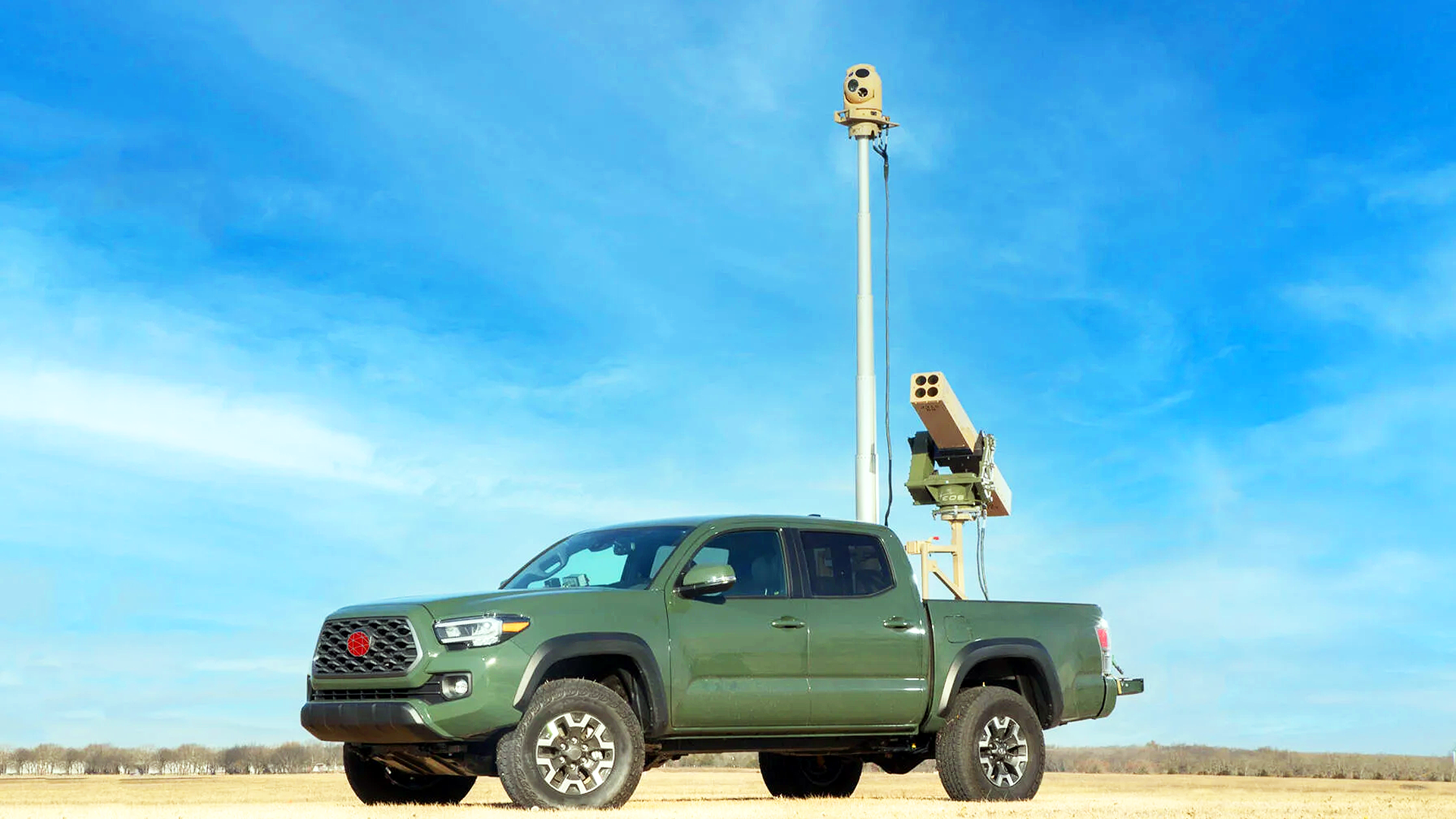
Credit: L3Harris
Deploying APKWS for C-UAV operations, the US Army has integrated a quadruple launcher with the Commonly Remotely Operated Weapon Station II (CROWS II) from Norway’s Kongsberg Defense, which can be mounted on a range of vehicles or static sites. The US Army has tested other international systems including the Thales Lightweight Multi-Role Missile (LMM), dubbed ‘Martlet’ in Royal Navy service. This is a semi-automatic command to line-of-sight (SACLOS), laser beam-riding missile fitted with a proximity fuze. In 2023, the Royal Navy tested the missile in the C-UAV role, during which it was launched from the Wildcat helicopter platform.
SAM-like effectors: Coyote and Roadrunner
The Raytheon Coyote Family is intended to be able to be launched from UAVs, helicopters and ground vehicles, and is designed to defeat Group 1–3 UAVs. The Block 2 version, which achieved IOC in 2019, was greatly redesigned compared to the Block 1B variant, fitted with a turbojet engine for propulsion in place of a pusher prop, and with upgraded with improved sensors, increased air speed of 370 km/h (200 kn), extended loiter time, greater range (10–15 km). The munition is fitted with a two-way datalink for communication and command updates, and a high explosive fragmentation (HE-FRAG) warhead.
The Coyote Block 2 was first used in combat in January 2023, defending US forces in Syria. By 2023, the Army had procured over 1,200 Coyotes and, in December 2023, announced plans to procure, during FY 2025–29, some 6,000 Coyote missiles, 252 fixed and 25 mobile Coyote launcher systems along with 118 fixed and 33 mobile KuRFS radars.
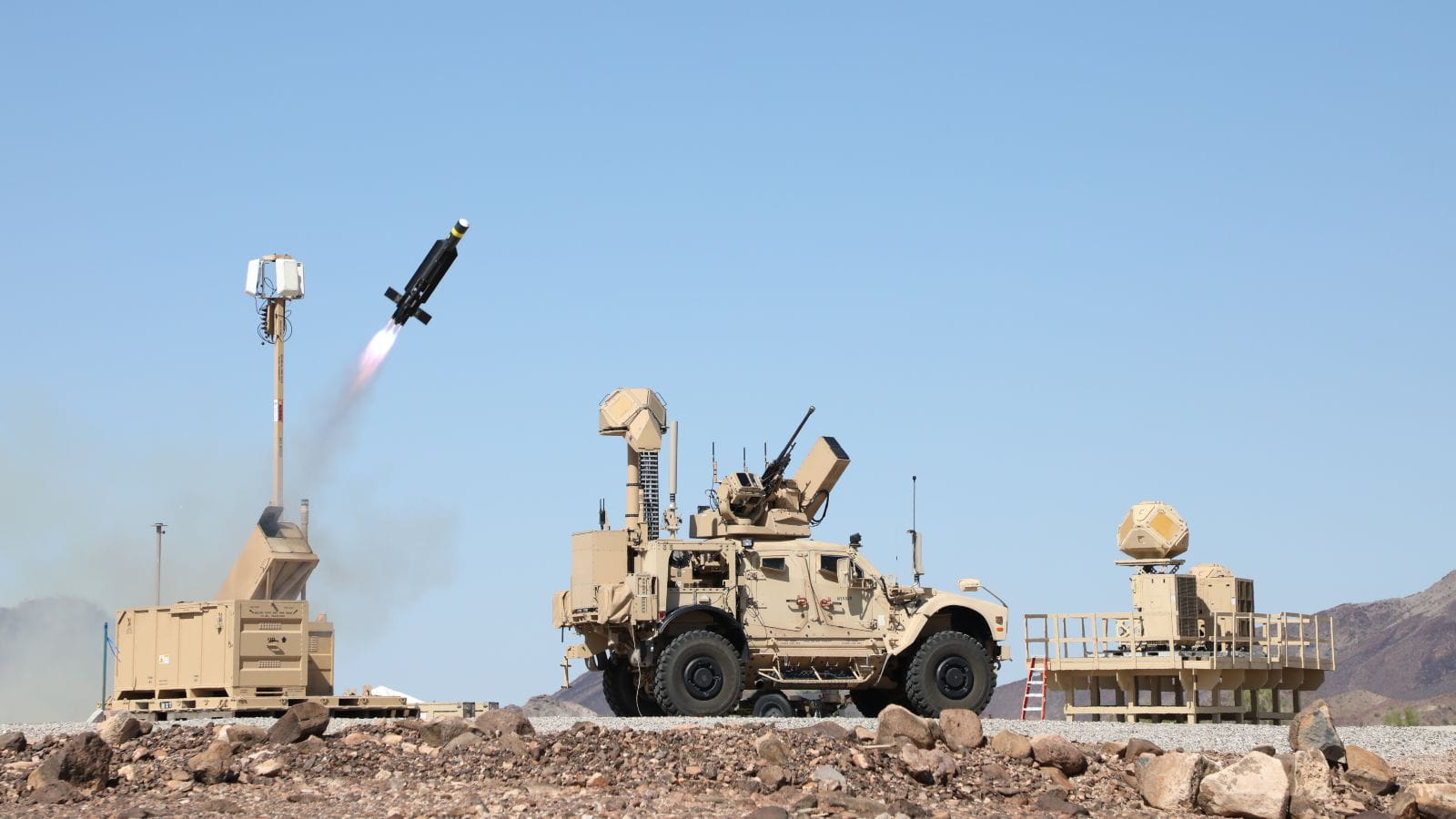
Credit: Raytheon
In the same category of SAM-like munitions is the Anduril Roadrunner-M, which received research and development funding in FY 2024, to meet a US Special Operations Command (SOCOM) requirement to defeat Group 3 UAVs. Earlier Roadrunner versions have already been deployed for operational evaluation. Unlike Coyote, the jet-powered Roadrunner is recoverable, allowing it to land and be retrieved for later re-use if it does not engage the target.
Technology: HELs
High-energy lasers (HEL) have been under development for decades. The proliferation of UAVs has provided an impetus to deploy these systems, offering low-cost interception and now capable of putting sufficient power on target to destroy UAVs. Static HEL systems include the 100 kW class Israeli Iron Beam, developed in cooperation with the US, which carried out live-fire testing in March 2022, and is reportedly due to enter service in 2025.
The US has deployed multiple C-UAV-capable HEL systems, though these have not yet reportedly been used in combat. In 2014, the US Navy introduced the shipboard 33 kW Kratos AN/SEQ-3 Laser Weapon System (LaWS) on the USS Ponce. This was followed, in 2019, by the Lockheed Martin High-Energy Laser with Integrated Optical Dazzler and Surveillance system (HELIOS) as Increment 1 of the Surface Navy Laser Weapon System (SNLWS) programme. The company has stated that during factory testing, HELIOS “routinely demonstrated full power operation above 60 kW” and the company has stated that HELIOS could be scaled to 120 km or higher within existing space, weight and power (SWaP) allocations for laser weapon systems on Navy vessels. A HELIOS Mk 5 Mod 0 version, mounted on the destroyer USS Preble in 2021, has been integrated with the ship’s Aegis combat system.
The US Navy envisions an SNLWS increment 2, with a beam power of 150-300 kW, which would be capable of defeating anti-ship cruise missiles (ASCMs) flying as crossing targets. This is planned to be followed by SNLWS increment 3, which is intended to be capable of defeating an ASCM flying directly at the host vessel.
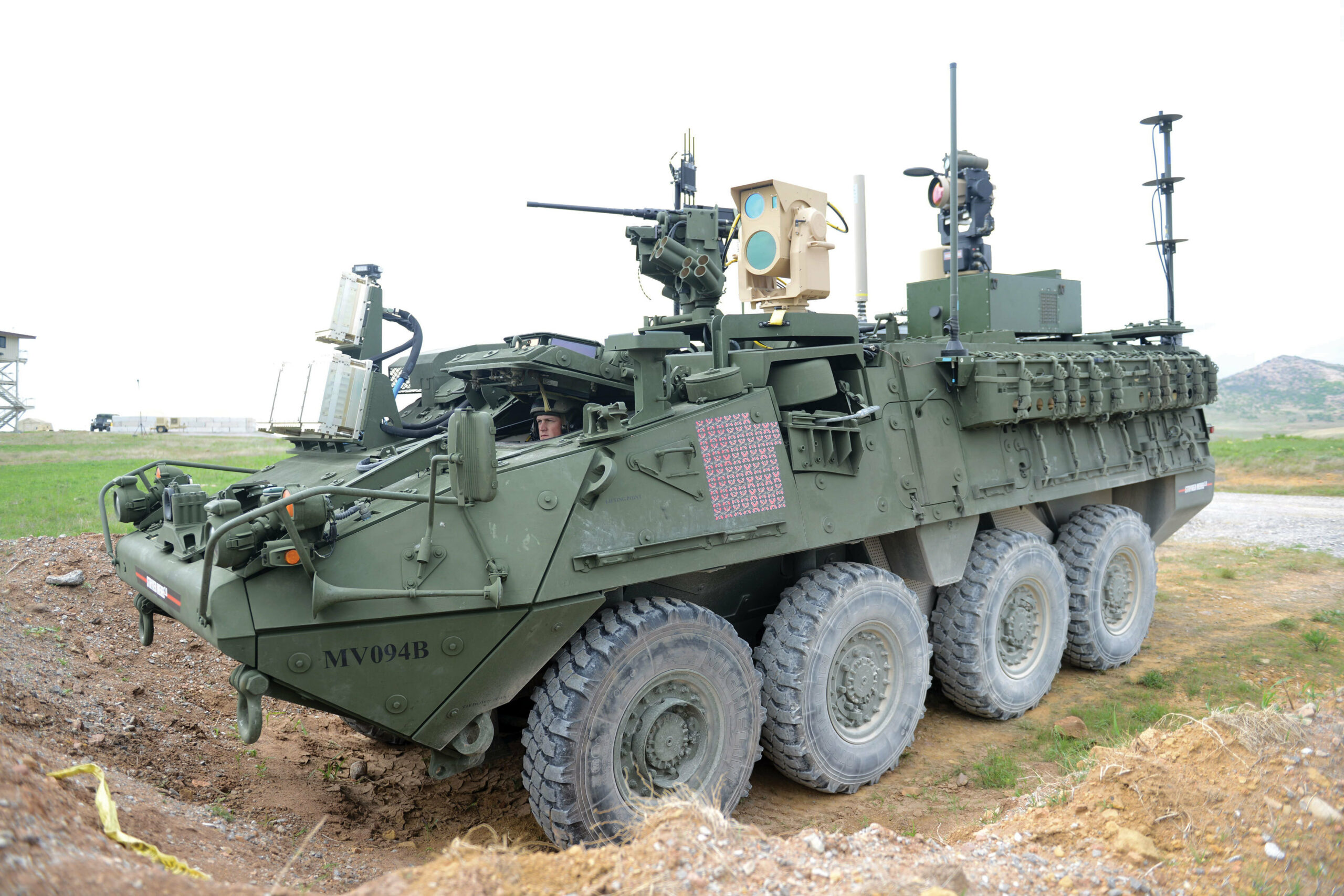
Credit: US Army/C. Todd Lopez
In 2019, the US Marines deployed the 5 kW Boeing Compact Laser Weapon System (CLWS), capable of being mounted on a tripod or a Joint Light Tactical Vehicle (JLTV), or a Stryker. Boeing had previously developed a 10 kW class laser for the High Energy Laser Mobile Test Truck (HELMTT) demonstrator, and are developing the 100 kW class Tactical Laser Weapon System together with General Atomics-Electromagnetic Systems (GA-EMS).
Developed in a 10-month programme by the Army’s Rapid Capabilities and Critical Technologies Organization (RCCTO) and integrated by SAIC, the Blue Halo LOCUST palletised HEL was developed for the JCO. It has a 2-20 kW scalable power output, and is intended to defeat Group 1 UAVs and C-RAM targets. The system was live-fire tested at Yuma Proving Ground in 2022. According to the manufacturer, the system was operationally deployed overseas. In April 2023, the US Army awarded Blue Halo a USD 45.7 million contract to develop a prototype of the system mounted on an Infantry Squad Vehicle (ISV), for the Army Multi-Purpose High Energy Laser (AMP-HEL) programme.
Part of the High-Energy Laser Weapon System (HELWS) programme, four Raytheon 10 kW HELs have been delivered – the first in October 2019 – to the Air Force Research Laboratory (AFRL). These are intended for overseas airbase defence, three mounted on MRZR all-terrain vehicles (ATVs) and one mounted on a pallet.
Not yet deployed overseas, the M-SHORAD Increment 2 Multi Mission High Energy Laser (MMHEL) Guardian system, developed by the RCCTO, is a General Dynamics Land Systems Stryker-series wheeled vehicle armed with a Raytheon/Kord Technologies 50 kW laser. The first four-vehicle platoon of prototype vehicles was delivered in September 2023. In live-fire testing at Fort Sill and the Yuma Proving Ground, they destroyed Group 1–3 UAVs. The MMHEL is scheduled to reach IOC in FY 2025.
Work on developing a near-term 300 kW HEL is being carried out by four companies: Lockheed Martin, Northrop Grumman, General Atomics and nLIGHT/Nutronics, intended for the Navy’s High Energy Laser Scaling Initiative (HELSI) and the Army’s Indirect Fire Protection Capability-High Energy Laser (IFPC-HEL) programme, dubbed ‘Valkyrie’. Deliveries of Valkyrie prototypes are scheduled to start in 2024.
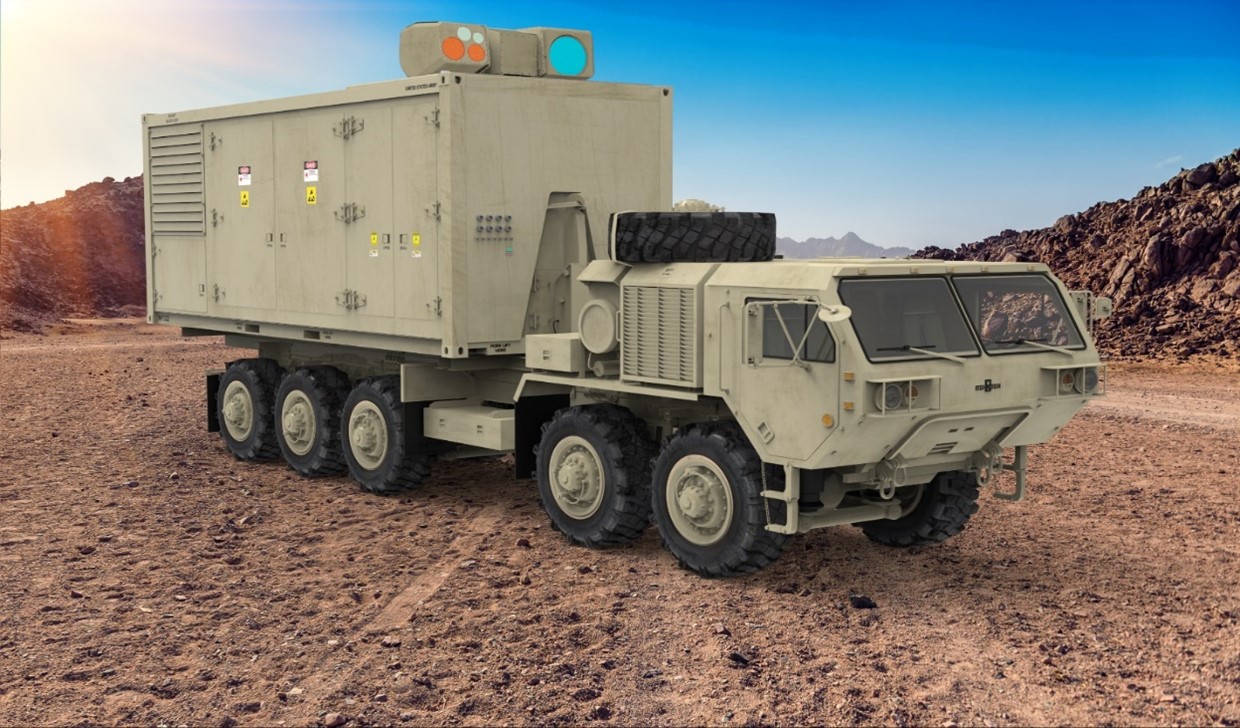
Credit: Lockheed Martin
China, Germany, Israel, Russia and the United Kingdom are among the countries known to have ongoing HEL programmes. China’s Poly Technologies Silent Hunter HEL, with a power output estimated between 30 Kw and 100 kW, has reportedly been used in combat by Saudi Arabia. The Rheinmetall Skyranger 30 HEL, announced in February 2022, integrates a 20 kW HEL (with planned output of 50 kW planned for the first phase, and provision for a follow-on 100 kW version) into an integrated C-UAV system. In 2023, Germany completed a year-long test of the MDBA Deutschland/Rheinmetall ARGE shipboard HEL. The UK’s DragonFire 50 kW class HEL, initiated in 2017 and integrated by an MBDA-led team with Leonardo and QinetiQ participating, successfully destroyed a target drone in live-fire testing in January 2024.
Technology: HPM
High power microwave (HPM) technology has the potential to defeat multiple or swarming UAVs simultaneously, while individual HELs must engage one target at a time. As with HELs, the US has deployed C-UAV HPM systems operationally, but has not reportedly used them in combat. The US plans on using HELs and HPMs together.
BAE Systems – in partnership with Leidos, Verus Research, and the AFRL – integrated a government-developed HPM into the prototype Tactical High Power Microwave Operational Responder (THOR) technology demonstrator, deployed for airbase defence to AFRICOM and CENTCOM, starting in 2020. It demonstrated its ability to defeat a Group 1 UAV swarm at 2,000 m range in tests at Kirtland AFB New Mexico in 2023. AFRL stated that a deployable prototype of the follow-on system, the Leidos Mjolnir, was slated for delivery in 2023.
As part of the Directed Energy Front-line Electromagnetic Neutralization and Defeat (DEFEND) programme, the Raytheon Counter-electronic High-Power Microwave Extended-Range Air Base Air Defense (CHIMERA), designed for longer-range engagements, completed a three-week field test at White Sands Missile Range New Mexico in January 2024. Previously, the US Air Force had tested the Raytheon Phaser HPM system in the close-range C-UAV role.

Credit: AFRL
Leonardo DRS’s Specialized Portable Electromagnetic Attack Radiator (SPEAR) HPM was one of four systems the US Army tested against swarming UAVs in April 2022 at Yuma Proving Ground, along with Epirus’ Leonidas HPM. Four trailer-mounted prototype systems were ordered by RCCTO in January 2023, with the first delivered in December 2023. They will be tested as part of the Indirect Fire Protection Capability-High-Power Microwave (IFPC-HPM) programme. Capable of being paired with the IFPC-HEL, IFPC-HPM may transition to a programme of record in FY 2025. In addition, the Leonidas is currently being integrated with the Stryker 8×8 platform, enabling it to be paired with the HEL-armed M-SHORAD Increment 2, mounted on the same vehicle and also using FAAD C2. This is due to be tested in 2024–25. In addition to the towed and Stryker-based variants, a miniaturised pod-mounted version of Leonidas, dubbed ‘Leonidas Pod’, capable of being carried by a relatively small UAV, has been developed for SOCOM.
To defeat swarming UAVs, the Coyote Block 3 SAM has been tested with a “non-kinetic effector”, referring to either an EW or HPM payload, according to the company it defeated a 10-strong UAV swarm during testing in 2021. In a similar vein, Lockheed Martin’s Mobile Radio Frequency-Integrated UAS Suppressor (MORFIUS), a tube-launched, fixed-wing UAV, uses HPM to defeat hostile UAVs.

Credit: Lockheed Martin
Technology: direct fire weapons
Guns remain the most widespread kinetic C-UAV technology. The challenge is to enable both a high rate of fire and proximity kills without ammunition costs and collateral damage concerns limiting their use. The US Army’s 30 mm XM1211 High Explosive Proximity (HEP), evaluated starting in 2023, and the XM1198 High Explosive Dual Purpose (HEDP) ammunition natures are intended to provide enhanced C-UAV capability for the XM914 30 mm chain gun mounted on the M-SHORAD Stryker. The follow-on XM1223 Multi-Mode Proximity Airburst (MMPA) is a HEP round being developed for FY 2027 as part of M-SHORAD Increment 3. Multiple guided 30–40 mm rounds with airburst capability have been proposed or developed for the C-UAV mission.
International gun systems are a mainstay of C-UAV active defence. The self-propelled twin 35 mm Gepard system has reportedly been highly effective in a C-UAV role in Ukraine. Rheinmetall established an ammunition production line, delivering an initial batch of 30,000 rounds to Ukraine in 2023. With regards to Germany’s efforts in this area, the Boxer 8×8 mounted Skyranger 30 A1, armed with Rheinmetall’s Oerlikon KCE-ABM 30 mm × 173 revolver cannon, carried out its first-live firing in December 2023, at the manufacturer’s proving ground in Ochsenboden, Switzerland. Germany has so far ordered 18 Skyranger 30 vehicles in a EUR 595 million contract in February 2024, with a prototype to be delivered by the end of 2024.
Technology: Non-kinetic
Non-kinetic active defence systems include radio frequency jammers, and/or spoofers. The former aim to disrupt the command links between UAVs and operators, or to disrupt UAV satellite navigation. Spoofing involves sending false signals, such as incorrect positioning information or commands.
In the US, in 2020, JCO selected, among other non-kinetic systems, the US Navy’s Northrop Grumman Drone Restricted Access Using Known EW (DRAKE); the system is a low-cost software-defined jammer, originally designed for vehicle use, that is now operational on warships.
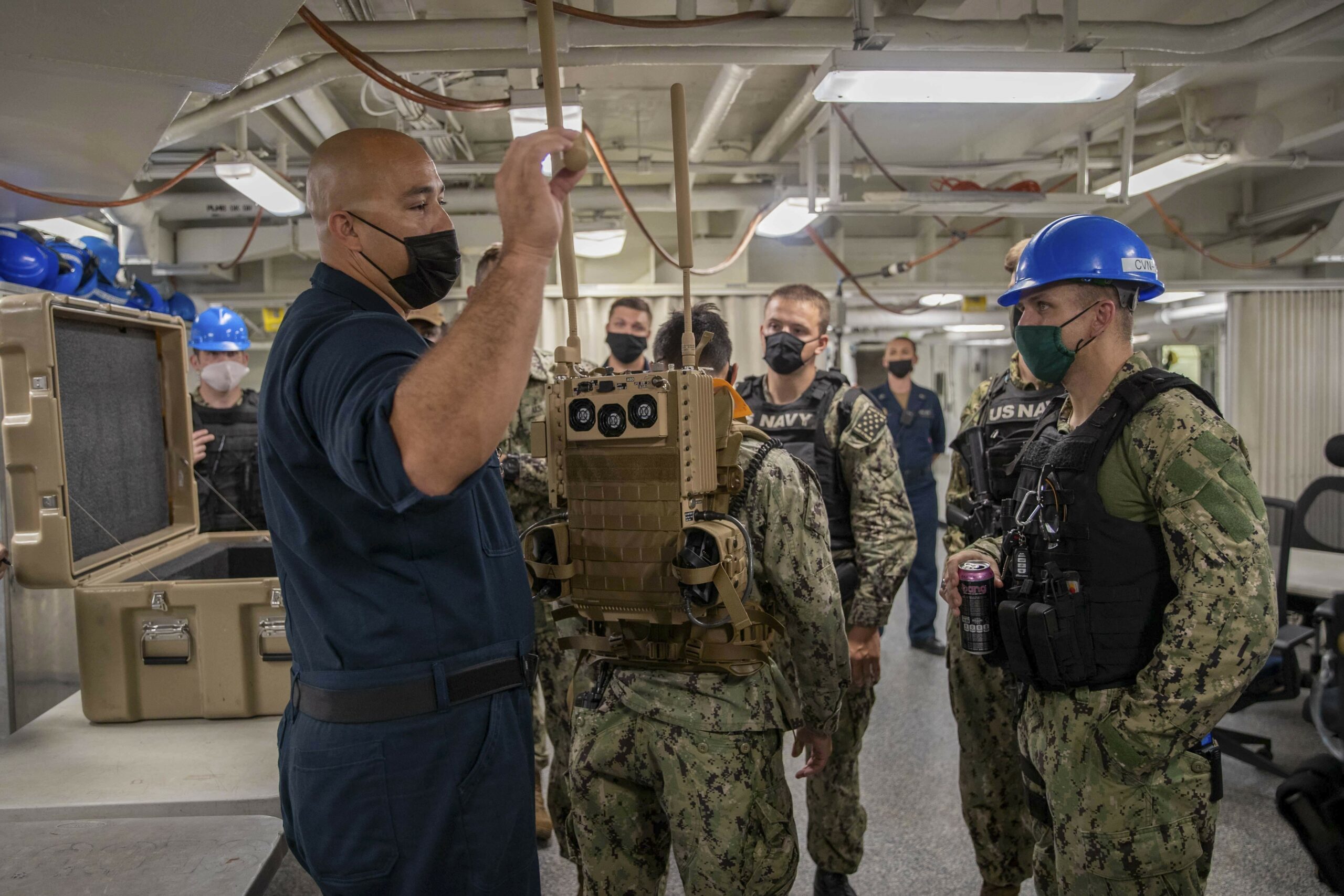
Credit: US Navy/Specialist 3rd Class Aislynn Heywood
In the European theatre, the Titan Blue Halo has been used in European Command (EUCOM) by SOCOM, and the AFRL’s Negation of Improvised Non-State Joint Aerial Threats (NINJA), capable of jamming and spoofing UAVs, has also been integrated with the Royal Air Force’s (RAF’s) ORCUS C-UAV system. Another notable European effort is the German Guardion system, a collaboration between Diehl Defence, ESG, and Rohde & Schwarz. This is a highly tailorable system which can incorporate a range of different sensors including radar, direction finders, optronic, acoustic sensors, and the possibility of multiple effectors ranging from various forms of jamming to kinetic and directed energy effectors.
While non-kinetic defeat technologies have the advantages of low costs and low footprint – in terms of systems deployed to forward areas – it is potentially vulnerable to changes in UAVs. Increased autonomy in flight operations and the use of automatic target recognition (ATR) guidance have already been reported in Ukraine, where UAVs have been modified to make it more difficult to be jammed or spoofed.
Tactics: Attack operations and passive defence
Attack operations and passive defence make it possible for active defence systems to limit the threat from UAVs. Ukraine’s armed forces have found that attack operations – locating controllers by triangulating on their signals and calling in artillery fire – are perhaps the most effective counter to the UAV threat.
The importance of passive defence has been reflected in the appearance of appliqué overhead protection on armoured vehicles in Ukraine and Gaza. Hardening, camouflage and frequent displacement are necessary for survival on a battlefield shaped by widespread UAV use. Combat lessons from Ukraine, along with NATO and US exercises, have shown the importance to troops of being alerted to UAVs in their immediate vicinity, to take cover, move, or engage.
Future C-UAV
C-UAV is being developed by fielding service-specific capabilities, yet effective operational architectures will be, of necessity, joint-service and multinational. While all types of forces – not just specialists – must be trained for and capable of C-UAV, how they conduct active defence without disrupting their own operations remains uncertain. While, looking at US experience, there has been significant success in demonstrating network connectivity, this is still far from the seamless linkages envisioned by the DoD’s Joint All Domain Command and Control (JADC2) concept.
Effective C-UAV has been demonstrated in Ukraine, in CENTCOM and in the Red Sea. These experiences have all underlined the importance of magazine depth at the point of need, which, in turns, emphasises cost and ability to be mass-produced. Complicating these requirements are the need for overlapping capabilities. A HEL that would be effective in the blue skies above the Red Sea may not be so during the storms and fog common to the Barents Sea.
The US approach to C-UAV shows examples of the extensive range of technologies being applied, with many solutions coming from outside major players in US industry. The need for near-term C-UAV capabilities has provided openings for international partners. However, integrating diverse systems and recent combat lessons into C-UAV architectures remains challenging, both for the US and internationally.
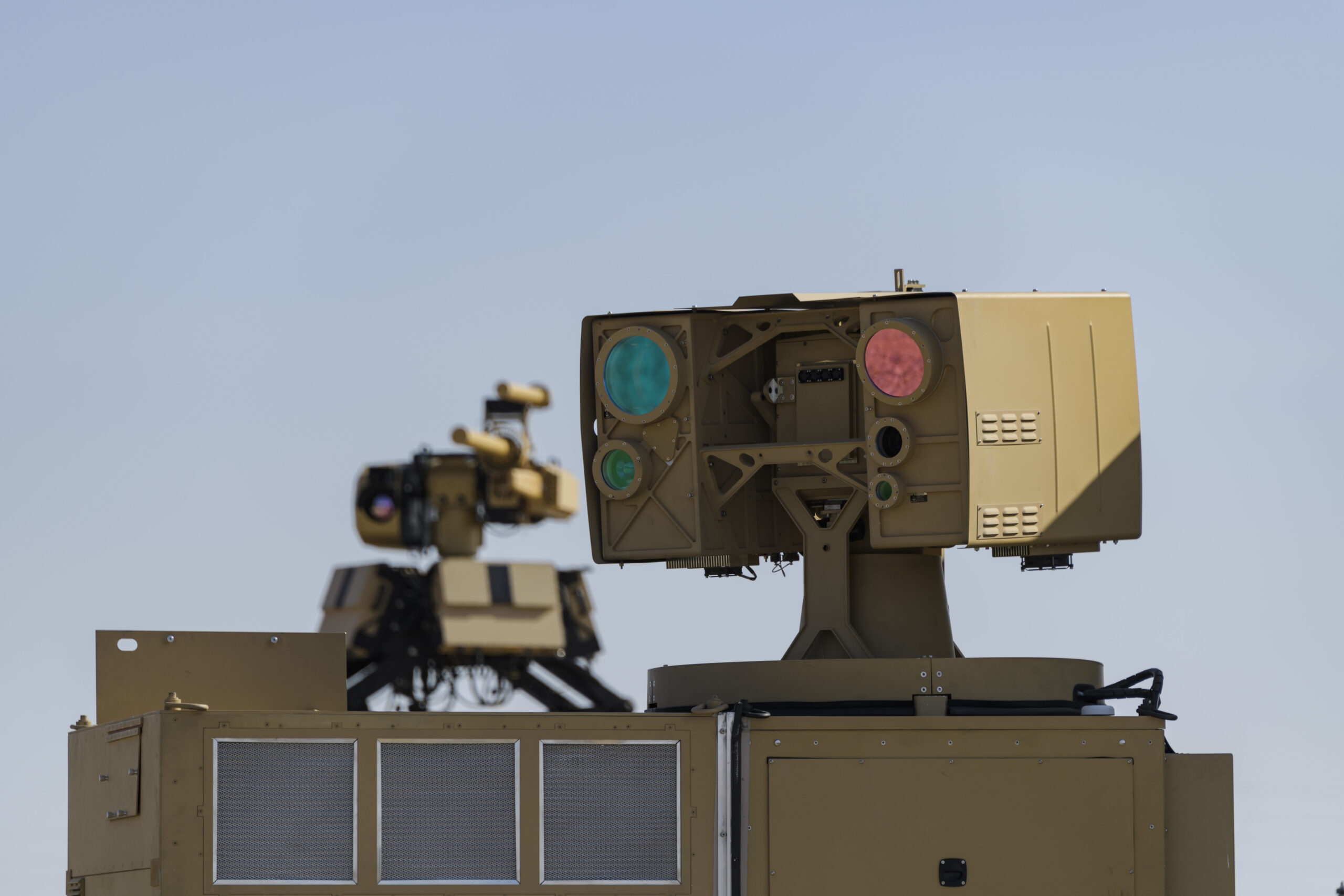
Credit: US Army/Brandon Mejia
In the US, the JCO has provided funding and expertise so that services can procure, deploy and operate C-UAV systems, operating the Joint C-UAS Training Academy, currently at Yuma Proving Ground – but due to move to Fort Sill, Oklahoma in 2024. While an Army organisation, reporting to an Army three-star General, the JCO has emphasised joint service and international cooperation. Whether the JCO will be able to move capabilities forward at a time of static – at best – expenditures and Congressional dysfunction delaying new start programmes, remains uncertain. Especially in the wake of the January 2024 UAV attack on US troops in Syria, the importance of the overall C-UAV mission will likely be reflected in the US and many other countries globally.
David Isby









